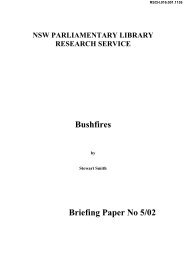the february 2009 fires - 2009 Victorian Bushfires Royal Commission
the february 2009 fires - 2009 Victorian Bushfires Royal Commission
the february 2009 fires - 2009 Victorian Bushfires Royal Commission
You also want an ePaper? Increase the reach of your titles
YUMPU automatically turns print PDFs into web optimized ePapers that Google loves.
The February <strong>2009</strong> Fires<br />
Fire Behaviour<br />
1.24<br />
1.25<br />
1.26<br />
1.27<br />
Fire behaviour results from <strong>the</strong> interaction of fuel, wea<strong>the</strong>r, topography and <strong>the</strong> fire itself. Overlaying this<br />
basic framework is a direct link between drought, increased fire activity and more intense fire behaviour. 49<br />
This summary of <strong>the</strong> fire behaviour on 7 February is drawn largely from <strong>the</strong> evidence of Dr Kevin Tolhurst,<br />
senior lecturer and researcher at <strong>the</strong> University of Melbourne.<br />
The wea<strong>the</strong>r conditions leading up to 7 February, and <strong>the</strong> combination of <strong>the</strong> drought and <strong>the</strong> heatwave,<br />
led to increased combustibility and volatile fire behaviour because many of Victoria’s normally moist forests<br />
were dry. 50 These forest fuels carried <strong>the</strong> fire more easily than ordinarily expected. In turn, this led to <strong>fires</strong> of<br />
exceptional severity. So <strong>the</strong> conditions leading up to 7 February not only dried out Mountain Ash forests,<br />
which ordinarily would have been too moist to burn, but also added additional fuel loads to <strong>the</strong>se forests. 51<br />
Areas of bush had also died due to <strong>the</strong> cumulative effects of <strong>the</strong> drought over preceding years. Mr David<br />
McGahy, <strong>the</strong> Arthurs Creek-Stra<strong>the</strong>wen CFA Brigade Captain who has lived in <strong>the</strong> area for 40 years,<br />
observed:<br />
… [<strong>the</strong> bush] was dying because of <strong>the</strong> cumulative effect of all <strong>the</strong> dry years. It was in a lot of trouble,<br />
<strong>the</strong> bush. I remember talking to one of <strong>the</strong> DSE chaps and he said, ‘If we cop a fire through here, it’s had<br />
it, this bush. It’s not going to regenerate because it is under too much stress now.’ So it was extreme.<br />
The week before we had had two or three days of 45 and it was just extreme. We knew if it came, it was<br />
going to be something special. 52<br />
1.28<br />
1.29<br />
1.30<br />
The fine fuels were desiccated by <strong>the</strong> conditions and <strong>the</strong>y added again to <strong>the</strong> fuel load. Fine fuels respond<br />
much more to <strong>the</strong> short-term conditions such as <strong>the</strong> temperature, relative humidity and local wind<br />
conditions. Woody fuels — twigs, branches and fallen leaves — add to <strong>the</strong> heat coming off <strong>the</strong> burnt<br />
area. They also add considerably to <strong>the</strong> heat in <strong>the</strong> main convection column which, in turn, drives <strong>the</strong> fire.<br />
Normally those woody fuels burn behind <strong>the</strong> firefront and do not contribute much to <strong>the</strong> nature of <strong>the</strong> fire.<br />
However, when <strong>the</strong>re is a large fire, under <strong>the</strong>se dry conditions, <strong>the</strong>y can add considerably to <strong>the</strong> convection<br />
column, which influences <strong>the</strong> whole firefront. 53<br />
The <strong>fires</strong> of 7 February did not progress in a single, easily distinguishable line — <strong>the</strong>re was a ‘fire zone’<br />
that extended kilometres ahead of <strong>the</strong> firefront. 54 As described in <strong>the</strong> paragraphs below, this zone<br />
contained spotting that started fur<strong>the</strong>r <strong>fires</strong>, which in turn burnt some areas well ahead of <strong>the</strong> main<br />
firefront. Subsequently, <strong>the</strong> main firefront passed over <strong>the</strong> same areas, fur<strong>the</strong>r burning any remaining<br />
fuel. This process expedited <strong>the</strong> progress of <strong>the</strong> <strong>fires</strong>.<br />
The <strong>fires</strong> varied in description and behaviour:<br />
■■<br />
■■<br />
■■<br />
■■<br />
classic grass and scrub <strong>fires</strong> in western Victoria<br />
conventional bush<strong>fires</strong> progressing from ground <strong>fires</strong> to flame heights of 30(+) metres<br />
55<br />
extensive spotting directly sighted 13–14 kilometres ahead of firefronts and estimated up to 35 kilometres<br />
ahead of firefronts, with greater spotting over shorter distances, causing additional <strong>fires</strong> to ignite 57<br />
spot <strong>fires</strong> fur<strong>the</strong>r from <strong>the</strong> firefront, burning in <strong>the</strong> direction of <strong>the</strong> prevailing wind, while spot <strong>fires</strong> closer<br />
to <strong>the</strong> main firefront burnt back towards <strong>the</strong> fire. 58<br />
56<br />
45
















